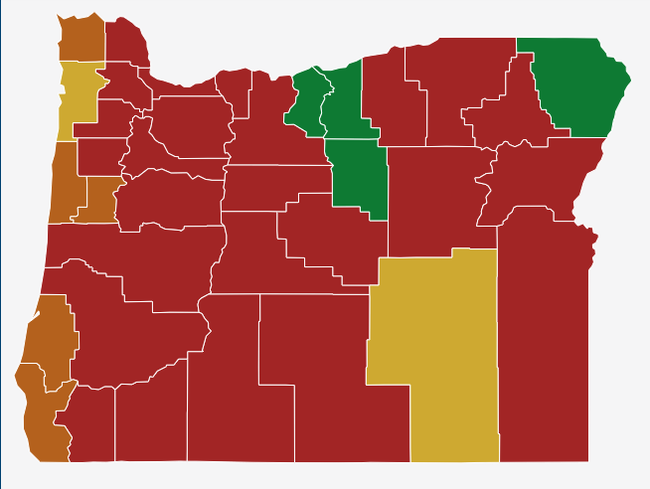 Most of Oregon remains in the “extreme” risk category created by public health authorities to adjust pandemic restrictions. (Courtesy/Oregon Health Authority)
Most of Oregon remains in the “extreme” risk category created by public health authorities to adjust pandemic restrictions. (Courtesy/Oregon Health Authority)
Gov. Kate Brown’s two-week “freeze” to slow the spread of Covid is officially over as of Thursday, Dec. 3.
But not much will change for residents of Marion and Polk counties who still won’t be able to eat inside a restaurant, see a movie or go to the gym.
After enacting the freeze, Brown created four risk levels — extreme, high, moderate and lower — for counties across the state based on the spread of the virus. Of Oregon’s 36 counties, 25 have been placed in the “extreme risk” category because of widespread transmissions of Covid. Marion and Polk counties are among them.
One of the biggest changes is that restaurants and bars can now offer outdoor dining, with a maximum of 50 people allowed at one time. An earlier limit that only six people from up to two households can sit at one table also remains in effect.
For counties in the extreme risk category, grocery stores and other retailers must reduce their capacity to 50% and are encouraged to facilitate curbside pickup. Under the freeze, retailers were allowed to operate at 75%.
Offices have been directed to allow remote working if possible and close to the public. Long-term care facilities still allow visits but only outdoors.
Residents of these counties can still get a haircut, have their nails done, see a chiropractor or receive other personal services with health guidelines in place. Private social gatherings are still restricted to six people from two different households.
Religious institutions and funeral homes have a maximum indoor capacity of 25% occupancy or 100 people, which is smaller. A total of 150 people are allowed outside. That’s more than what was allowed under the freeze, which limited services to 25 indoor and 50 outdoor.
To move out of the “extreme risk” category, Marion and Polk counties would have to record fewer than 200 new Covid cases per 100,000 residents over two weeks, and reduce the percentage of Covid tests that are positive to 10% or fewer. Both remain far from hitting the target for new cases.
Oregon has seen new cases of Covid and hospitalizations reach new highs. Over Thanksgiving week, the Oregon Health Authority reported 9,100 new daily Covid cases, a 5% increase over the previous week.
According to the most recent numbers from the Oregon Health Authority covering Nov. 15 through Nov. 28, Marion County has 492 cases of Covid per 100,000 residents a 10.3% testing positivity rate. Polk County has 431 cases per 100,000 residents and a 10% testing positivity rate.
Gilliam, Sherman, Wallowa and Wheeler counties are the only four in the “low risk” category. But even those counties face restrictions. Restaurants and movie theaters are still limited to 50% indoor capacity, while grocery stores and other retailers are limited to 75%.
According to the governor’s office, county risk levels will be reassigned every two weeks. The next reassignment will be on Friday. Dec. 18.
Contact reporter Jake Thomas at 503-575-1251 or [email protected] or @jakethomas2009.
OUR HOLIDAY SPECIAL: Save 25% and support careful, in-depth reporting on your community. https://www.salemreporter.com/subscribe









